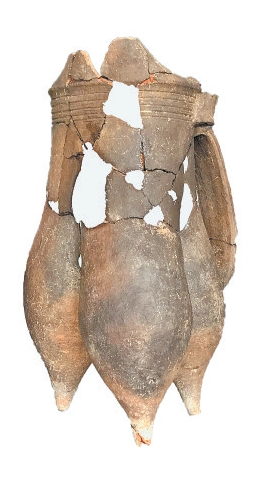The Life of the People in the Xia Dynasty
The Life of the People in the Xia Dynasty
科技视野下 夏代人这样生活
In recent years, multidisciplinary and sci-tech approaches have been widely used to study the culture of China's Xia Dynasty (around 2070-1600 BC), presenting a vivid picture of the people's life at that time.
近年来,多学科融合、科技考古越来越多地介入夏文化的探源与研究中。通过动物考古学、植物考古学、环境考古学、冶金考古学等科技考古视野,展开了一幅夏代人的生活画卷。

A pottery cooking vessel of the Xia Dynasty. [Photo provided to Henan Daily]
What was the climate like during the Xia Dynasty?
夏代是什么样的气候?
It is a critical period for the origin and evolution of the Chinese civilization from the late Longshan Culture (2500-2000 BC) to the Xia Dynasty. Archaeological data shows that the climate from the Longshan Culture to the late Xia Dynasty represented by the Erlitou site dating back to 3,500 to 3,800 years ago gradually changed from the warm and humid one to a cold and dry one.
龙山晚期到夏代,是中华文明起源的关键时期。数据分析显示,从龙山到二里头,气候逐步由温暖湿润向干冷转变。
What were the staple diets of the people in the Xia Dynasty?
夏代人的主要口粮是什么?
Featuring agriculture and livestock, the subsistence economy witnessed various staple diets of the people in the Xia Dynasty. Dryland farming, especially millet, was the core of agriculture at that time. Apart from broomcorn millet, soybean was also a necessary supplement with rice occupying a small proportion. Livestock included pigs, dogs, cattle, goats and sheep, of which the pig was a staple diet. Besides, deer also played a significant role in their diets.
农业和家畜是生业经济的主体,人类食物来源多样。农业以旱作农业为绝对主体,并且以粟为主、黍为辅,大豆也是必要补充,稻的比重很小。家畜包括猪、狗、黄牛、羊,其中,猪是人类的主要肉食来源,羊包括山羊和绵羊。鹿类动物在先民食谱中同样占有重要地位。

A pottery jar of the Xia Dynasty. [Photo provided to Henan Daily]
How about their physical fitness?
夏代人的体质怎么样?
The period from the late Longshan Culture to the late Xia Dynasty witnessed a high infant and child mortality rate. The pathological manifestations of anaemia and scurvy were frequently seen in the remains of juveniles discovered at several sites. Besides, meningitis has also been observed in their skulls. That is to say, most people suffered from nutritional deficiencies in their childhood, and infections related to malnutrition might be the main cause of their death.
龙山晚期至二里头人群具有较高的婴幼儿死亡率,多处遗址的未成年个体常常出现贫血和坏血病的病理表现,颅骨内壁也多观察到曾经患有脑膜炎,可见,龙山晚期至二里头人群多在儿童时期患有营养缺乏类疾病,推测与营养不良有关的体内感染是其死亡的主要原因。
How about their height?
夏代人的身高如何?
Their height varies greatly, as data acquired from the sites of different periods shows. The highest height is about 168 and 175 centimeters respectively for women and men in the Longshan Culture, while about 155 and 170 centimeters in the late Xia Dynasty.
两性的身高在不同遗址差距较大,龙山时期女性最高身高在168厘米左右,男性最高能达175厘米左右;二里头时期女性最高身高在155厘米左右,男性最高在170厘米左右。(中文来源/河南日报 记者/张体义 编译/赵汉青 何蒙贺 审校/张军平)
